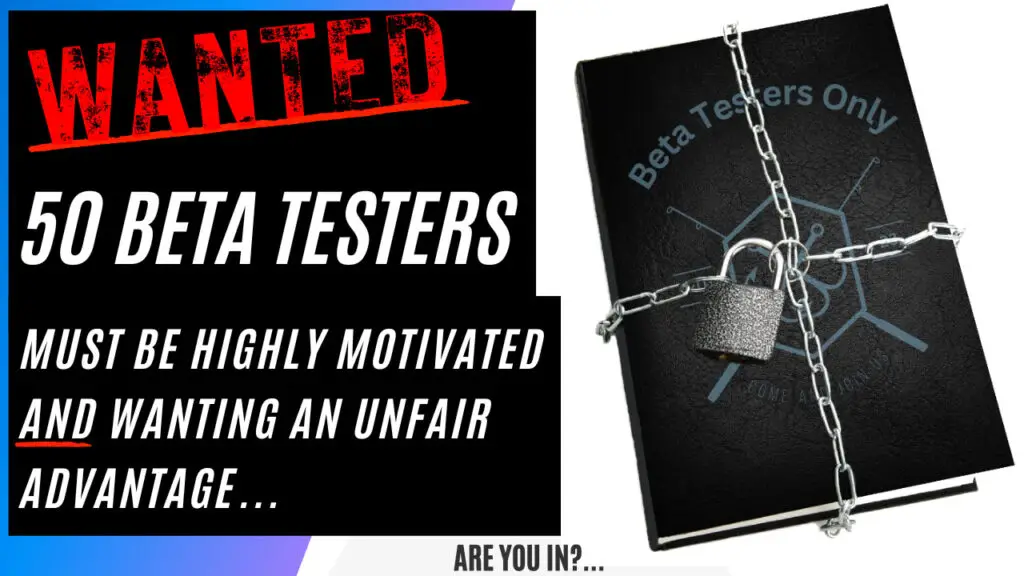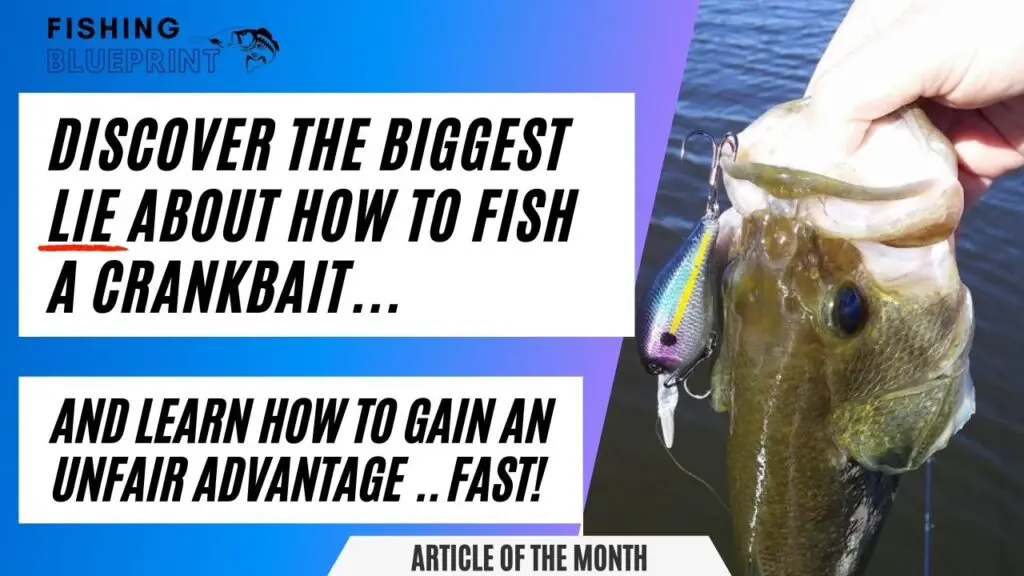How To Fish Lake Camanche | Your Lake Camanche Fishing Report
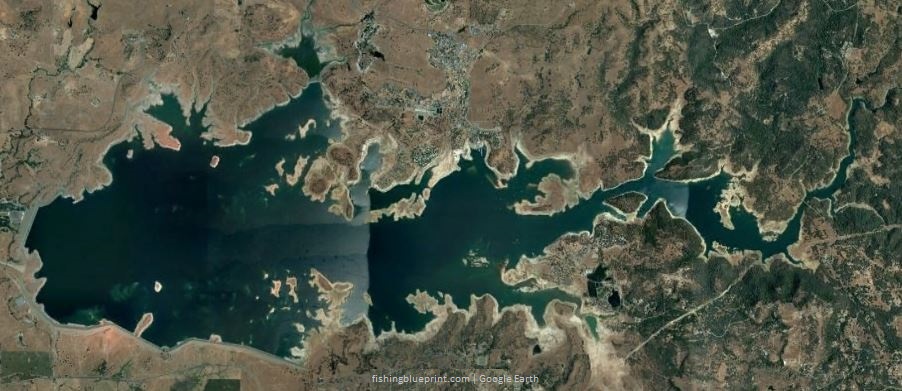
Lake Camanche, officially known as “Camanche Reservoir” is a large man made lake that sits 119 miles away from San Francisco and 373 miles away from Los Angeles.
Overall it’s a popular lake located just outside of Stockton California. In this post you’re going to be given the blueprint to fish this lake.
So what are the best tips for fishing Lake Camanche? There are three important factors you must know if you want to know how to fish Camanche Reservoir successfully. First, you need to know what kind of fish is in Camanche Reservoir. Second, it’s important for you to know which part of the lake each species can be found. Lastly, knowing what are the best baits that work on Camanche Lake is vital. However, tactics, baits, and locations will be different for each type of fish that you target. So let’s talk about the steps you need to take in order to give you the best chance of catching a fish on Camanche Lake.
Key Takeaways
This lake gives locals and visitors the opportunity to test their luck in catching one of the many game species this lake has to offer, such as trout, bass, catfish, bluegill, and much, much more!
Here’s the most recent and updated Lake Camanche Fishing Report – it gives you a quick and easy list of some really good fishing spots. If you’re looking for more detail on how to fish each spot scroll down into the article.
- Camanche Dam
- Northwest Cove
- Rabbit Creek
- Cramper Bay
- Sugarloaf
- The Narrows
- China Gulch
- Southeast River Coves
- Camanche Bay
- Stump Islands
Here are some additional fast and helpful tips just for you:
- The easiest way to fish this lake is by boat, but there are areas to fish from the bank, or by kayak or float tube.
- There are multiple public boat ramps to use.
- Camping and RV parking is available.
- You can buy tackle and groceries at the lake or at one of the tackle shops in Phoenix.
About Lake Camanche
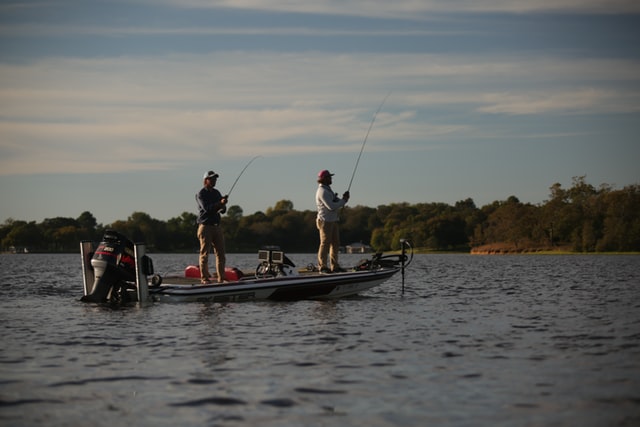
Camanche Lake is a deep body of water with the average depth being 20-50 feet and a maximum depth of 126 feet when the lake is completely full. Being 5 miles long and 3 miles across. Fishing Camanche Lake can be excellent because the lake spans over 7,700 acres and has 53 miles of shoreline anglers can target. This reservoir plays a vital role in collecting water to be used for drinking water, farming, and flood control.
Important Lake Warnings
Algae blooms may be present which may affect fishing, swimming, and water contact in general.
According to parks.ca.gov, “every one of California’s new laws requires boat operators to have a California Boating Card. The card is required for anyone under the age of 41 to operate a boat in California’s waters.”
If you are fishing and camping, fire bans may be in effect due to the ongoing drought conditions.
What Kind Of Fish Are In Lake Camanche
Rainbow Trout
Brown Trout
Kokanee Salmon
Largemouth Bass
Smallmouth Bass
Spotted Bass
White and Black Crappie
Bluegill and Sunfish
Perch
Catfish
Lake Camanche Fishing Tips & General Strategies
Water Clarity
At Lake Camanche, you can expect clarity for days. The water is generally clear to moderately stained, which means you can spot those lurking lunkers with ease. Keep in mind, though, that water clarity can vary based on rainfall and other factors. So, be prepared to adapt your tactics accordingly.
Structures and Cover
When it comes to bass hideouts, Lake Camanche is the real deal. Here are some common types of structure and cover you’ll find in this bass haven:
- Rock on!: Lake Camanche is a rocky paradise with plenty of submerged rockpiles, boulders, and riprap banks to explore. These spots are prime real estate for bass, so make sure to cast your line and feel the bass-thumping action.
- Timber-riffic: This lake is also a wood-lover’s dream. You’ll find submerged trees, stumps, and laydowns that provide excellent ambush points for both largemouth and spotted bass. Be ready
Springtime Fishing Update Fishing On Lake Camanche
Air Temperature: Spring air temperatures at Lake Camanche typically range from the mid-50s to mid-70s °F. The warmer weather starts to activate the bass, making it an excellent time to hit the water.
Wind Speed & Direction: Moderate wind speeds, ranging from 5 to 15 mph, are common during spring. The winds usually blow from the northwest, but keep an eye on weather reports as wind patterns may shift, influencing fishing conditions.
Water Temperature: In spring, the water temperature at Lake Camanche gradually rises, usually hovering between 55 and 65°F. As the water warms up, bass become more active, moving into shallower waters to feed and spawn, presenting prime opportunities for anglers to hook into some impressive catches.
Largemouth Bass
- Spawning Time: Largemouth bass spawn at Lake Camanche typically begins in mid-spring, usually between late March and April, depending on water temperatures.
- Spawning Locations: Prime spawning areas for largemouth bass include shallow bays, coves, and the edges of the lake around rocky cover and sunken bushes. Big and Little Hat Islands are well-known for their near-perfect bass habitat.
- Water Temperature: Bass generally begin spawning when the water temperature reaches 60-65°F.
- Post-spawn Behavior & Locations: After spawning, bass move to deeper waters to recover. During early summer, look for them in depths between 20 and 45 feet. As the water continues to warm up, they will stay in deeper water until the fall. Target deeper channels, drop-offs, and underwater structures to find bass during the post-spawn period.
Trout
- Spawning Time: Rainbow trout in Lake Camanche spawn during late winter and early spring, usually between February and April.
- Spawning Locations: Trout prefer gravel-bottomed streams or areas with clean, well-oxygenated water for spawning. There may be limited spawning opportunities for trout in the lake itself, but nearby tributaries or streams could be suitable spawning locations.
- Post-spawn Behavior & Locations: After spawning, trout return to deeper, cooler waters within the lake. During the spring and early summer, trout can be found cruising just a few feet below the surface. As the water temperature rises, they move to depths around 45 feet or more in search of cooler waters. To locate trout, try trolling along the channels and open deeper waters of the main lake, working your way from the North Shore boat launch to the dam. Bank fishing can also be productive during the cooler months. Keep in mind that trout tend to be more active during overcast or windy conditions, so adjust your fishing strategies accordingly.
Salmon (Kokanee)
- Spawning Time: While Lake Camanche has a limited population of kokanee salmon, spawning typically occurs during the fall, from September to November.
- Spawning Locations: Kokanee salmon prefer cold, clear tributaries or streams with gravel beds for spawning. It’s worth noting that the kokanee population in Lake Camanche may not be substantial enough for a significant spawning event, but nearby Pardee Lake offers better opportunities for kokanee fishing.
- Post-spawn Behavior & Locations: After spawning, kokanee salmon die, and their carcasses provide nutrients for the aquatic ecosystem. However, if you’re looking for salmon fishing opportunities in the area, consider visiting Pardee Lake or other known kokanee fishing
Summer Fishing Update On Lake Camanche
During the summer months of May, June, July, and August, Lake Camanche in California experiences typical Mediterranean-type climate patterns. Here’s what you can expect:
Summer Weather Patterns
- Air Temperature: Summer temperatures at Lake Camanche can range from the high 70s to mid-90s (°F) during the day, with May being the mildest month and July and August often being the hottest. Nighttime temperatures tend to cool down significantly, sometimes dropping to the 50s (°F).
- Wind Speed and Direction: Lake Camanche can experience variable wind conditions during the summer months. The wind typically blows from the west or northwest, with average speeds ranging between 5 and 15 mph. Wind patterns can be more unpredictable during the afternoons, with occasional gusts or calm periods.
Water Temperature & Fishing Presentations
- Average Water Temperature: The average water temperature at Lake Camanche during the summer months can range from the low 70s to mid-80s (°F). As the water temperature increases, fishing presentations for bass and trout will need to be adjusted to target deeper waters.
- Bass: As bass move to deeper waters in response to increasing water temperatures, presentations like deep-diving crankbaits, Carolina rigs, drop-shot rigs, or jigging techniques will be more effective. Focus on submerged structures, ledges, and drop-offs to locate bass.
- Trout: Trout will also seek cooler waters in deeper parts of the lake during summer. Trolling with spoons
Here are some tips on catching trout and Kokanee on the lake during the summer
- Summer months can be challenging as the fish tend to go deeper in the cooler waters, so consider using downriggers to get your bait deeper.
- Trolling is a popular method for catching trout and Kokanee on the lake. Use a combination of flashers and lures to attract the fish.
- Vary your speed and depth until you find what works best for the day.
- When fishing for Kokanee, use smaller lures and bait.
Here are some common baits for catching trout and Kokanee on Lake Camanche:
- Nightcrawlers
- PowerBait (in garlic, chartreuse, and rainbow colors)
- Kastmasters
- Rooster Tails
- Needlefish
- Wedding Rings
- Apex Lures
- Dodgers
Here are five specific locations where you can catch trout and Kokanee on Lake Camanche:
- The Narrows
- Hat Island
- The Dam Area
- The South Shore Pond
- The North Shore Day Use Area
Summertime Bass fishing tips
Lake Camanche is a great spot for bass fishing during the summer months. Here are some tips on the best techniques to use:
- Bass are more active in the early morning and late evening when the water is cooler. Fishing during these times can be more productive.
- Fish around structures such as docks, submerged trees, and weed beds.
- Topwater lures can be effective in the morning and evening when the fish are feeding near the surface.
- During the day, switch to deeper water and use deeper diving lures or jigs.
Here are three common reaction style baits for catching bass on Lake Camanche:
- Crankbaits (such as Strike King KVD Square Bill)
- Spinnerbaits (such as Booyah Pond Magic)
- Chatterbaits (such as Z-Man ChatterBait)
Here are three common finesse style baits for catching bass on Lake Camanche:
- Drop Shot Worms (such as Roboworm)
- Senkos (such as Gary Yamamoto Senko)
- Ned Rigs (such as Z-Man Finesse TRD)
Here are five specific locations where you can catch bass on Lake Camanche during the summer:
- The Narrows
- Little Hat Island
- The South Shore Day Use Area
- The North Shore Day Use Area
- The dam area
Other fish you can catch
In addition to trout, Kokanee, and bass, Lake Camanche is home to a variety of other game fish. Here are some tips on how to catch them:
- Catfish: Use cut bait or stink bait and fish around submerged structures, especially at night.
- Crappie: Fish around submerged trees and brush with small jigs or live minnows.
- Bluegill/Sunfish: Use small hooks and bait with worms, small pieces of nightcrawler, or small jigs tipped with a bit of bait.
- Carp: Use corn, bread, or boilies on the bottom of the lake or suspended under a bobber.
- Channel and Blue Catfish: Use chicken livers, live bait, or stink bait, and fish around structures, especially in deeper water.
- Rainbow Trout: Besides summer, they are stocked annually during the winter months. Anglers use powerbait, nightcrawlers, or lures like Kastmasters or spinners.
It’s important to check the regulations on Lake Camanche before you go fishing, as bag limits and other restrictions can vary by species and season. Additionally, local bait and tackle shops can provide up-to-date information on what baits and techniques are currently working best.
But Where Are The Best Places To Fish At Lake Camanche?
And in no particular order here is that list of the best fishing spots at Lake Camanche.
DISCLAIMER: The material provided is for general information purposes only. It’s important to understand that any information provided in this article can change at any time. Any maps or graphics featured are not to be used as navigational aids. Fishing Blueprint will not be responsible for any personal injury or property damage from any misuse of the maps or graphics provided. It’s completely impossible to give you every single spot where you can potentially catch a fish. But, what this list does do is to give you a helping hand and narrow down to the most productive fishing spots.
Camanche Dam
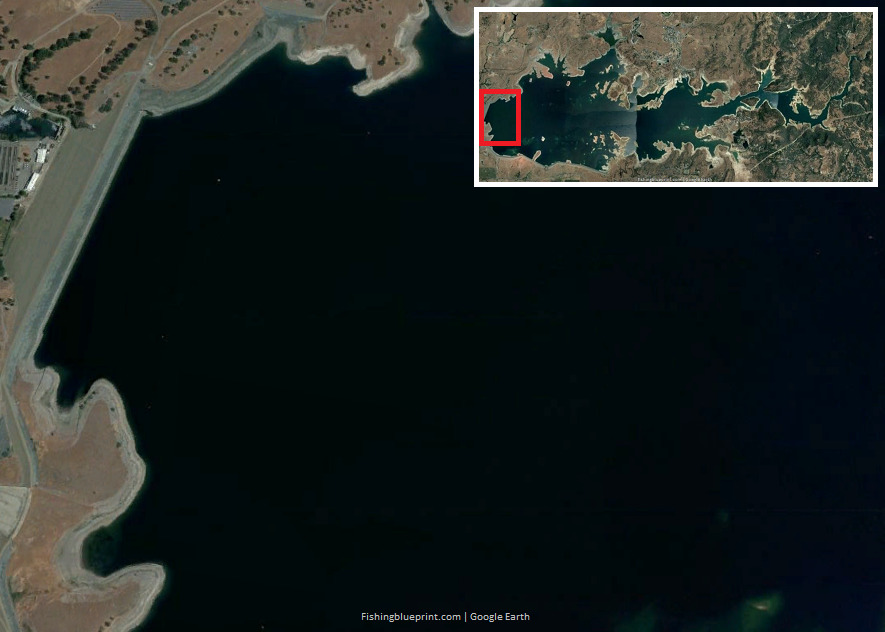
Located: western part of the lake
Structural features: cold deep water
Best species to target: trout, kokanee
Most effective way to fish this spot: Boat
Northwest Cove
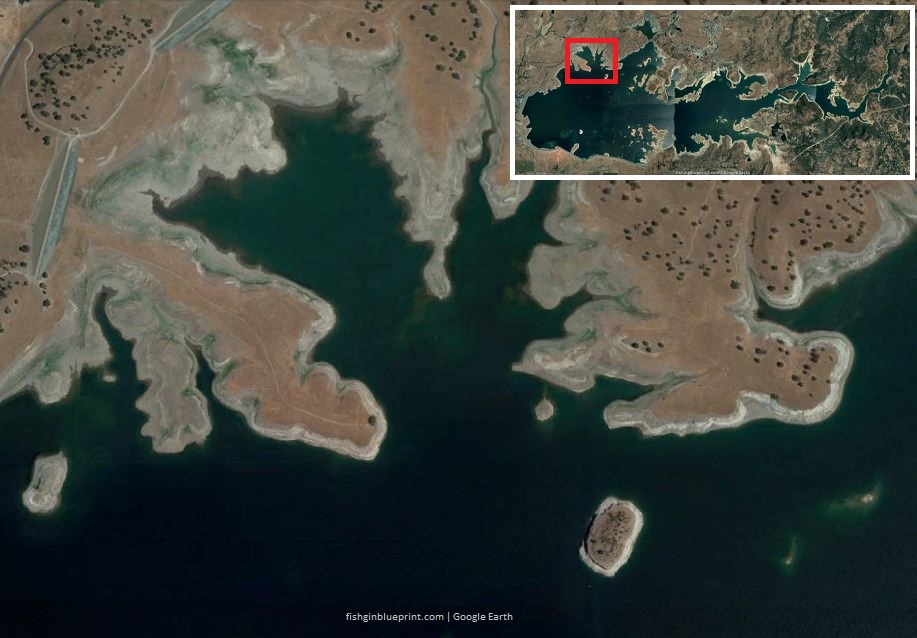
Located: West lake in south arm
Structural features: Deep cove, drop offs, humps, ledges, submerged humps.
Best species to target: Trout, kokanee, bass, crappie
Most effective way to fish this spot: Shoreline, float tube, kayak or boat Trolling with a downrigger, trolling without a down rigger
Rabbit Creek
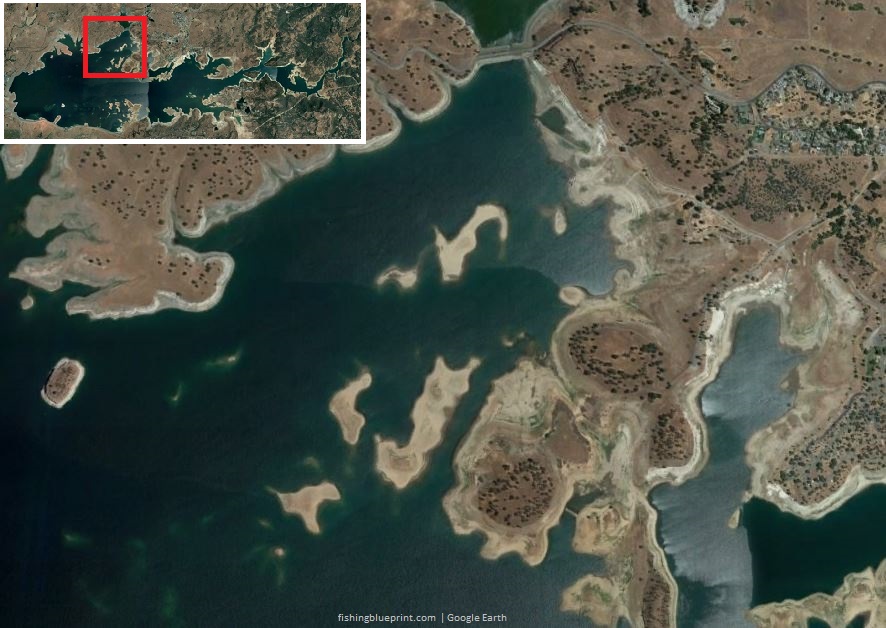
Rabbit Cove can offer great fishing for nearly all species of fish such as trout, kokanee, bass, and crappie.
Similar to the Northwest Covie, the mouth of the cove especially around Hat Island is an excellent place to troll for trout and kokanee salmon. Focus on drop offs, humps, and points.
Below I featured for you a couple pictures of Rabbit Cove with the water drawn down. There you’ll be able to see all the structure and cover the fish use.
Look carefully…

Look carefully…
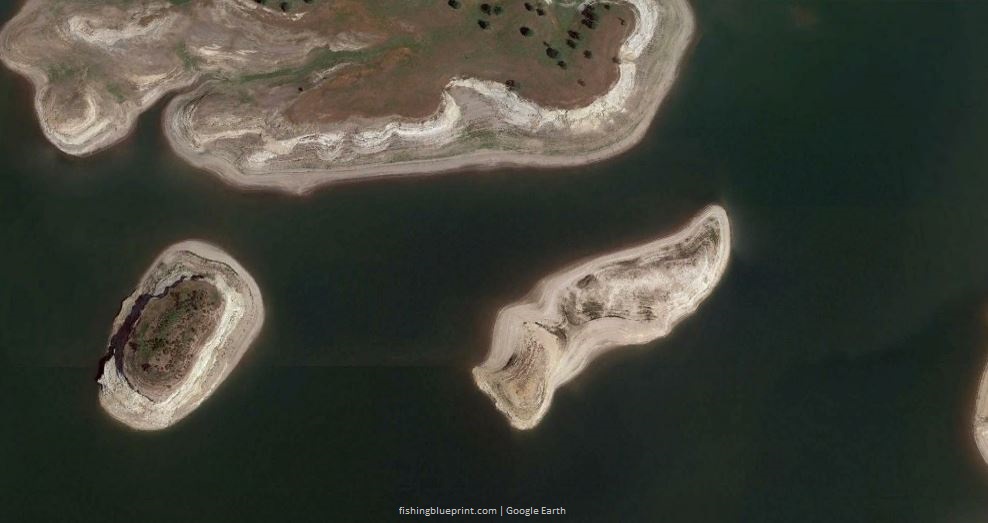
Largemouth bass and crappie can primarily be found toward the back of the cove relating to submerged brush piles, ledges, and humps with rock piles.
Best places to graph over would be toward the back of the cove where you’ll find a large ledge created by the old Rabbit Creek, numerous drainage ditches on the west side of the cove, as well as any submerged island that has deep water nearby.
Located: West lake
Structural features: Deep cove, drop offs, humps, ledges, submerged humps.
Best species to target: Trout, kokanee, bass, crappie
Most effective way to fish this spot: Shoreline, float tube, kayak or boat
Cramper Bay
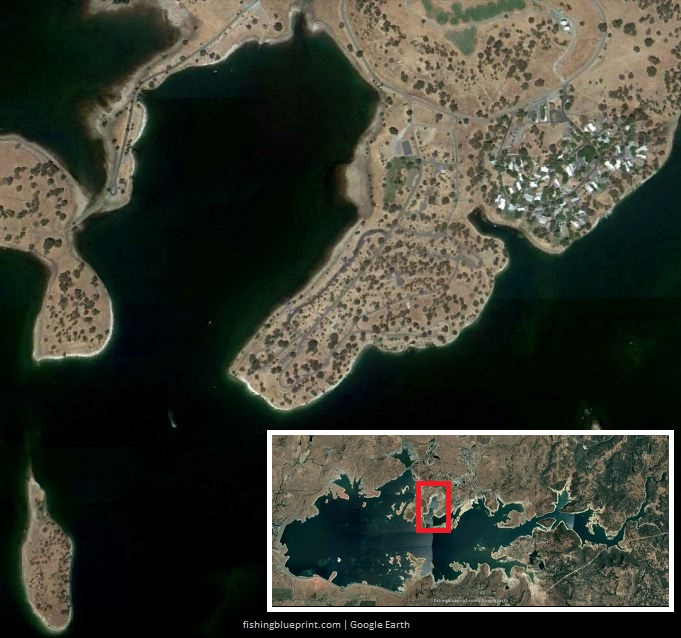
This long teardrop-shaped cove is fed by a single deep feeder arm into the lake. At times the fishing here can be extremely good. There are even reports you can catch a boat load of fish in less than an hour.
The cove holds submerged brush which can be good for largemouth bass, smallmouth bass, spotted bass, bluegill, and crappie.
Below I featured for you a couple pictures of this fishing spot with the water drawn down. There you’ll be able to see all the structure and cover the fish use.
Look carefully at this spot with low water level…
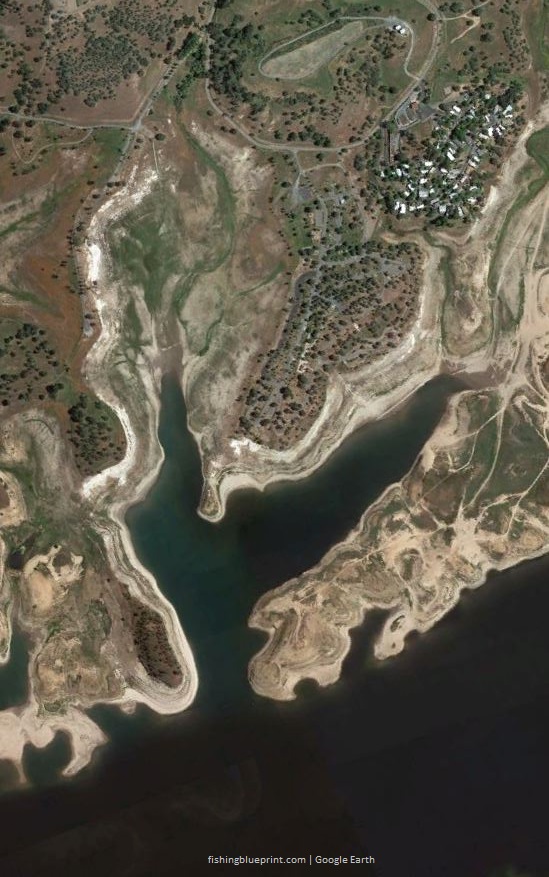
Look carefully at this spot with low water level…
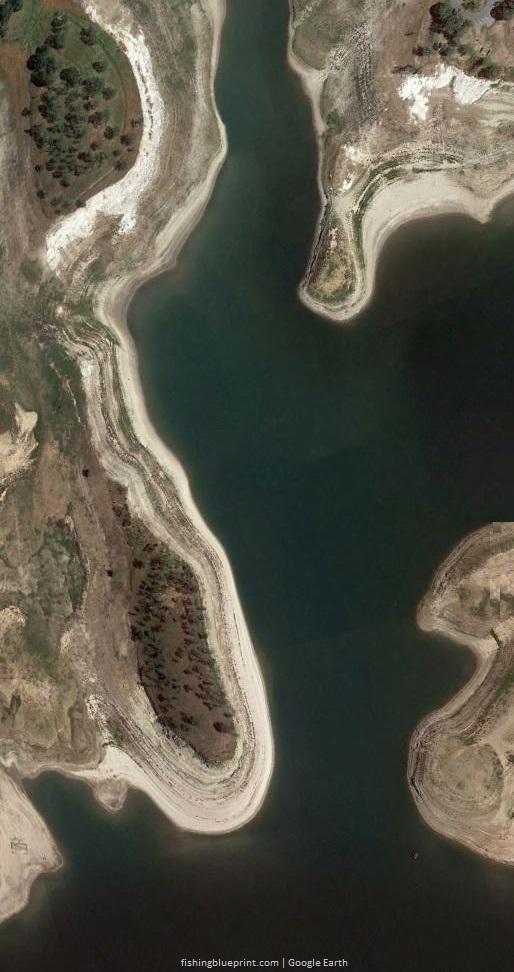
The middle of the cove is great for night fishing for catfish and crappie.
The eastern point tends to hold the most fish due to its steep rocky structure and also has a submerged hump off the tip of it.
In the summer you have the option to fish at the mouth of the cove targeting isolated humps, rock piles, and ledges. Or you can travel up the river and flip flooded that may have grown when the lay was low.
Always have a topwater bait tied on; these bass love to chase shad to the surface, so either a topwater popper, walking bait, or buzzbait should be considered.
The mouth of the cove is decent for trout and kokanee fishing.
Located: Southwest end of the lake
Structural features: Submerged brush and timber, rocky points, deep channel, channel swings, ledges, and drop offs,
Best species to target: Largemouth bass, smallmouth bass, spotted bass, catfish, bluegill, and crappie
Most effective way to fish this spot: Boat, kayak, float tube
Sugarloaf
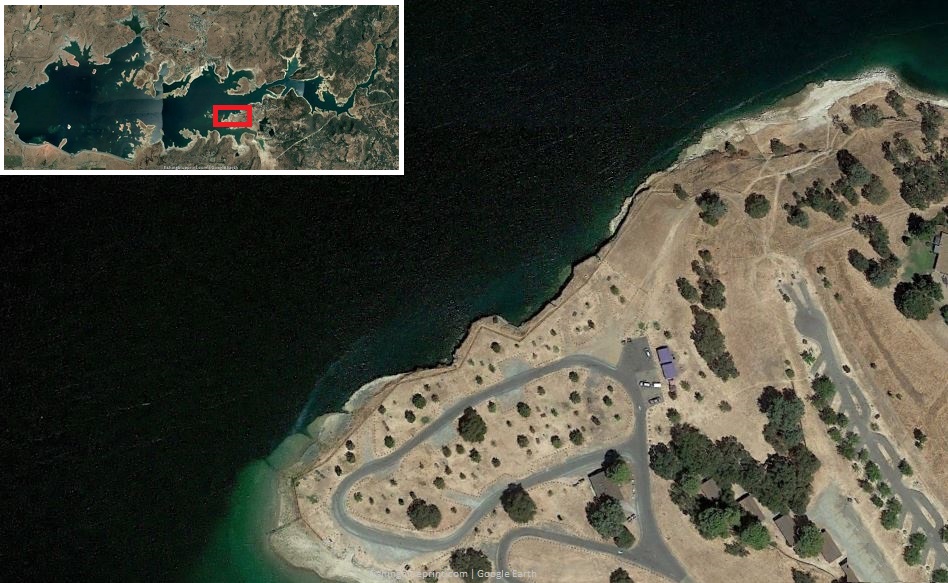
This spot is a bluff wall where the river channel swings into a bluff wall and it can be fished year-round.
The bass will commonly hold close to the large boulders (especially in the shadows), on the submerged shelves, or located on the bluff wall-to-bank transitions areas. Looks for transition areas that turn from steep rock walls to boulders, then to chunk rock and pea-gravel.
Trolling or shore fishing for trout and kokanee can be excellent here.
Look carefully at this spot with low water level…

Located: mid lake southern side
Structural features: bluff walls, chunk rock
Best species to target: bass
Most effective way to fish this spot: boat or kayak
The Narrows

This section features a long narrow stretch of canyon. The banks are characteristically very steep bluff walls on both sides and the water is deep.
The sides of the canyon banks consist of large chunk rock to boulder-sized substrate.
This area attracts coldwater-loving fish like kokanee salmon, lake trout, rainbow trout, and even some brown trout.
Look carefully at this spot with low water level…
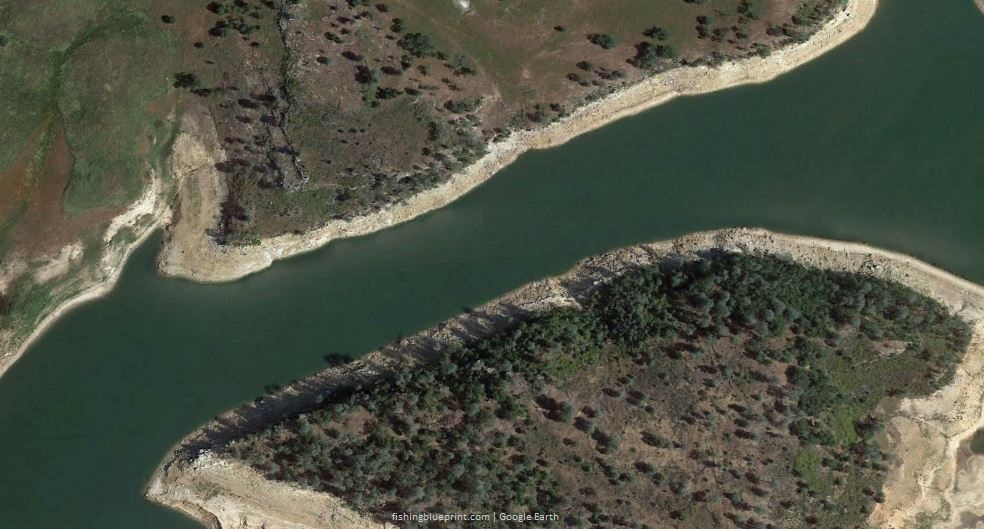
Look carefully at this spot with low water level…
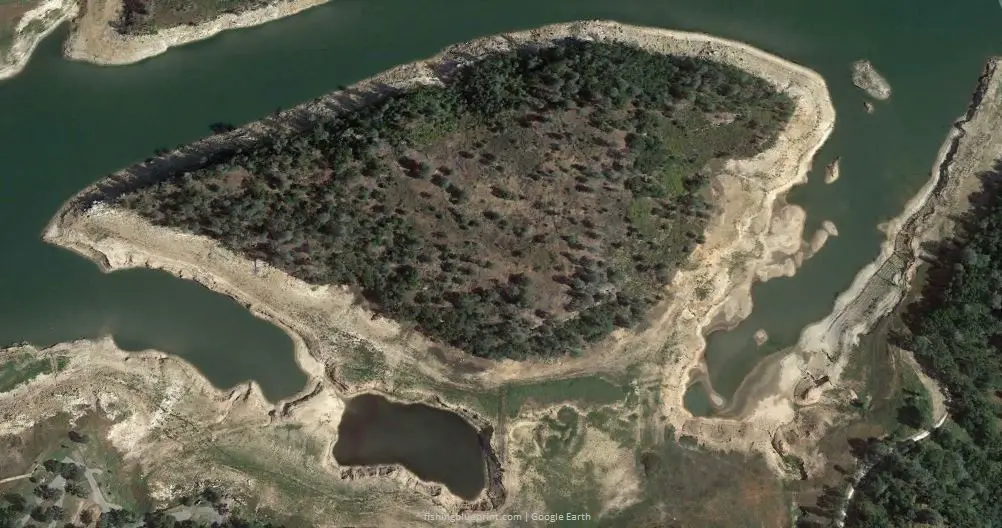
This spot can also be fished year-round, and the bass will commonly hold close to the large boulders (especially in the shadows), on the submerged shelves, or located on the bluff wall-to-bank transitions areas. Looks for transition areas that turn from steep rock walls to boulders, then to chunk rock and pea-gravel.
Additionally, the stretch of water just south of Narrows Island features also features steep rocky banks, ledges, ditches, and even a large depression. This small area needs to be scanned for fish every time you come to the lake.
Trout and kokanee will suspend in the middle of the main channel and tend to avoid the warmer southern bend.
Located: mid lake southern side
Structural features: bluff walls, chunk rock
Best species to target: bass
Most effective way to fish this spot: boat or kayak
China Gulch

This long straight cove features a deep channel fed by several feeder creeks.
A really great hallmark about this fishing spot is there is one main creek channel that runs down the middle of it however, there are several other ditches (smaller secondary creek channels) that run into it, kinda like a leaf.
Look carefully at this spot with low water level…
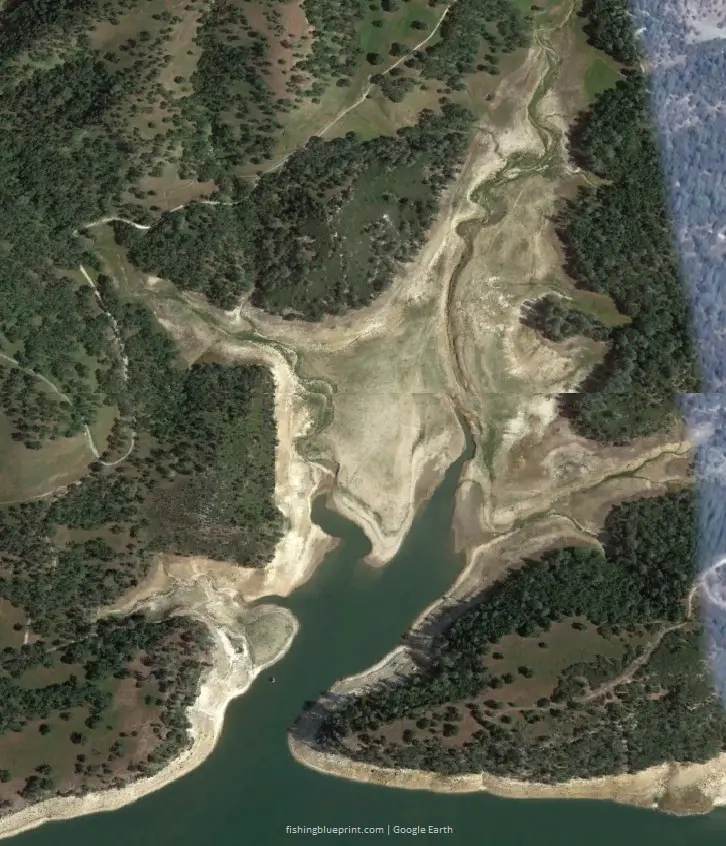
Scan the intersections for ledges, drop offs, boulders, rock piles, and ridges associated with the two intersecting channels.
Scan the main lake points carefully, as these areas will always hold fish.
The main lake points and the mouth of the cove will also hold trout and kokanee.
Located: eastern lake, north side
Structural features: inside bend main-lake point, ledges, rocky banks, secondary intersecting creek channels
Best species to target: Bass, crappy, catfish
Most effective way to fish this spot: boat
Southeast River Coves
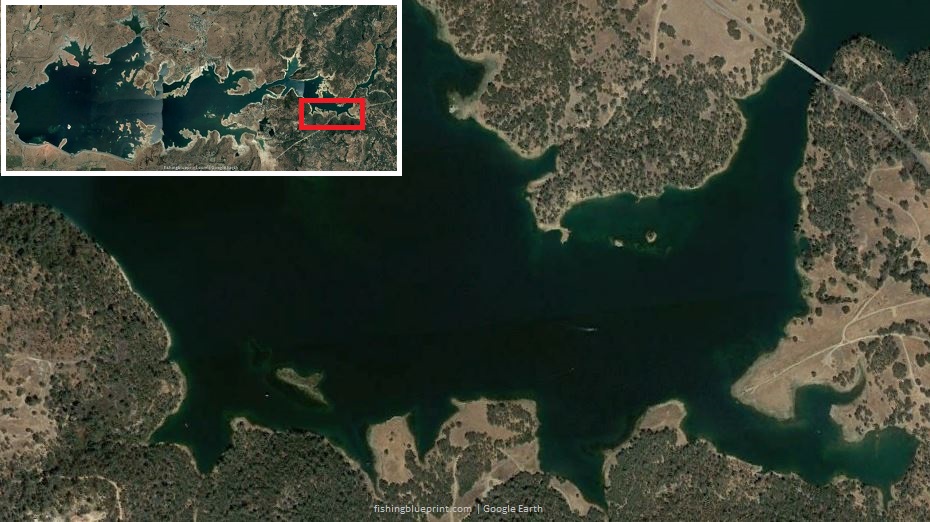
This spot is defined by a deep water channel swing that runs into several smaller coves.
Each cove gives the angler multiple structures you can target fish.
The most productive areas will be where any channels or ditches are close to another type of structure (such as points, ledges, ridges, drop offs, or humps), or close to some form of cover (brush piles, laydowns, vertical standing timber, roadbeds, docks, bridge pilings or any other form of artificial structure).
Look carefully at this spot with low water level…
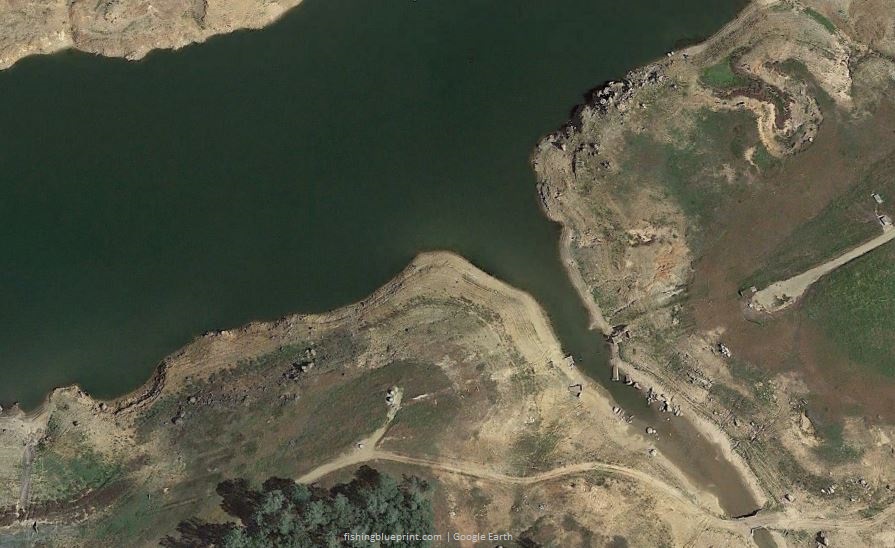
Look carefully at this spot with low water level…
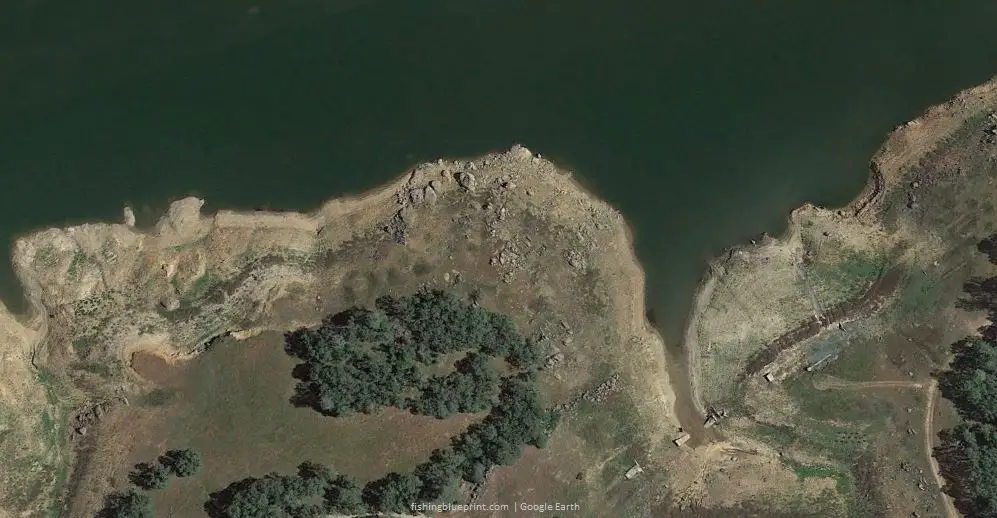
Before trying to fish everything, be sure to take some time and look this area over with your fish finder. If you see any bait, most likely bass relating to that particular spot. If you see bait or bass in the spot then fish it.
Trout and kokanee can be caught from boat or from shore here as well.
Located: eastern lake, south side
Structural features: deep river channel swing, rocky coves with other structures
Best species to target: bass and rainbow trout
Most effective way to fish this spot: boat
Camanche Bay
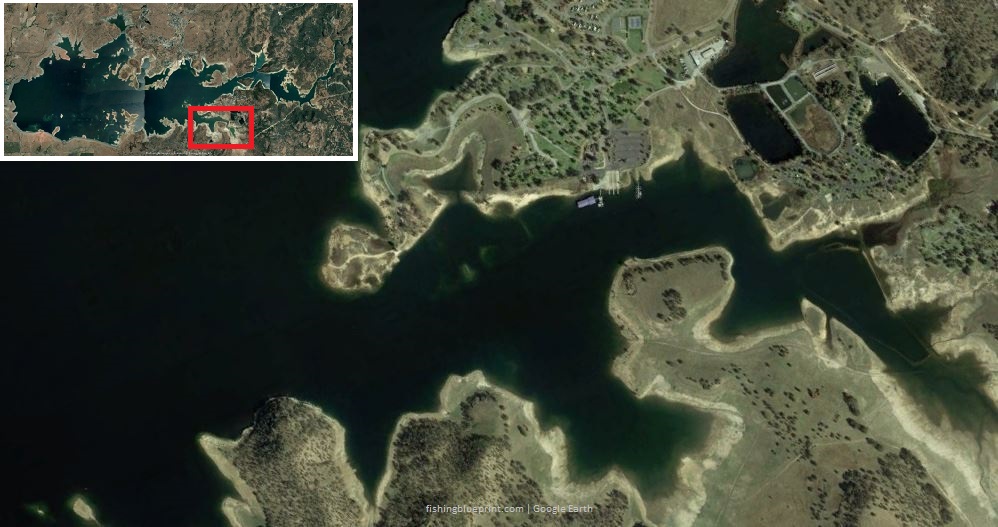
This long winding cove features several creek channel swings fed by several feeder creeks.
It’s important to scan this area, particularly the creek and smaller ditch channels that have ledges, drop offs, and rocky high spots, ridges associated with the creek channel swings.
The mouth of the cove also has planted artificial habitats for fish and also attract trout.
Look carefully at this spot with low water level…
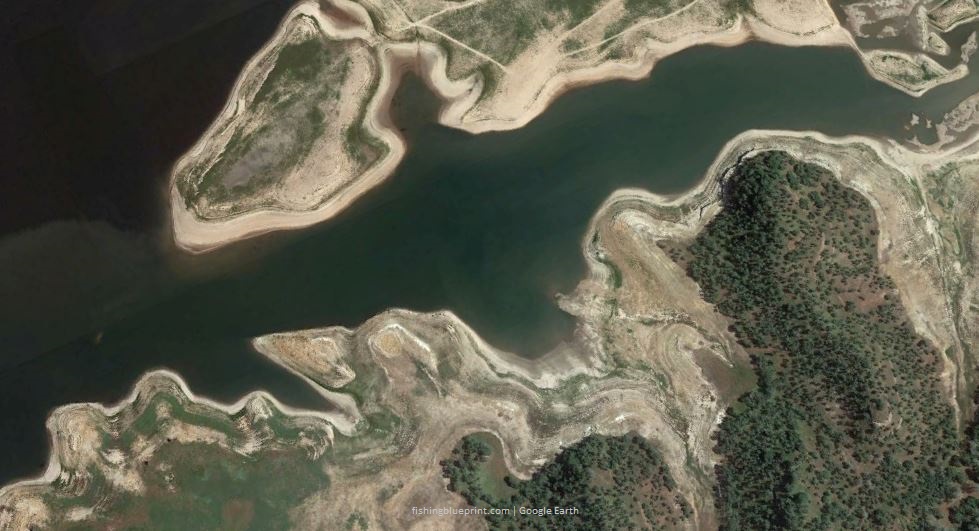
Located: southeast cove
Structural features: secondary creek channel swing, rocky coves, artificial structures
Best species to target: bass, rainbow trout, crappie, catfish
Most effective way to fish this spot: boat, kayak, shoreline
Stump Islands
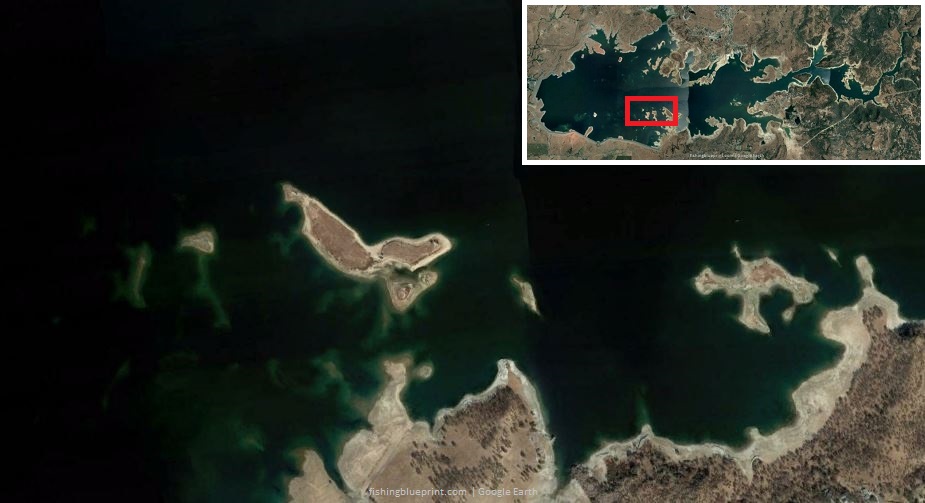
This is a large open bay that is best described by having several humps and high spots that are near the main lake’s river bend. This bay has many different structures you can target and fish.
Fishing the humps and ridges near the main river bend can be extremely productive. However on the other hand, fishing can be difficult because of the wind in this area.
Owning a spot lock trolling motor is pure gold in this section of the lake.
Look carefully at this spot with low water level…
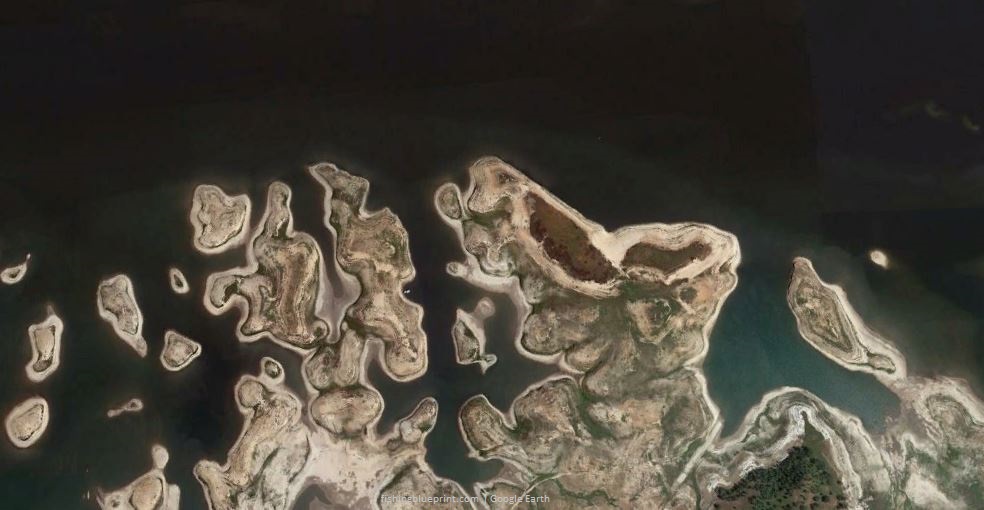
Moving further into the bay, make sure to scan the ditch and channel intersections.
Located: south section of the lake
Structural features: main lake river channel, rocky islands and humps, channels, ridges, and ledges.
Best species to target: bass, rainbow trout, crappie, catfish
Most effective way to fish this spot: boat, kayak
Boat Ramps at Lake Camanche
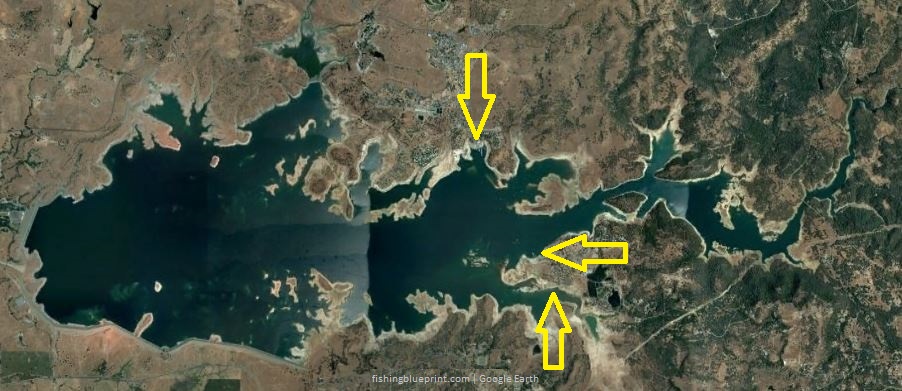
Luckily there are multiple boat ramps for you to choose from. However, as a heads up, ramp closures can happen at any time so be flexible just in case you need to launch at a different ramp.
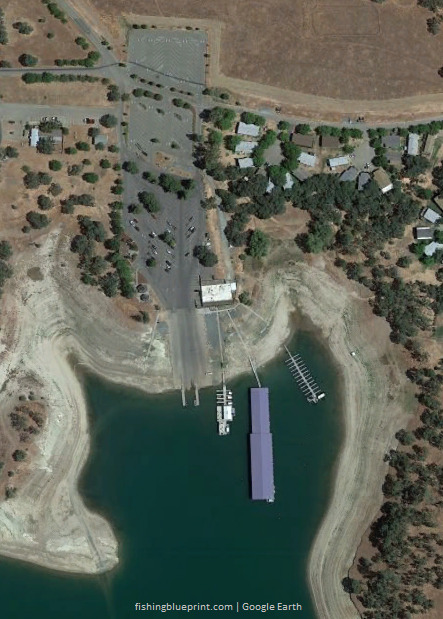
North Shore Camanche Boat Launch & Marina
Address: Shawnee Ct, Ione, CA 95640
Website: golakecamanche.com
Phone number: (209) 763-5166
Lanes: 6
Restrooms: Yes
Showers: no
Gas: Yes
Tackle, groceries, snacks available: Yes
Fish Cleaning Station: Yes
Camping nearby: Yes
South Shore Camanche Boat Launch & Marina
There are two launches on the south shore peninsula.
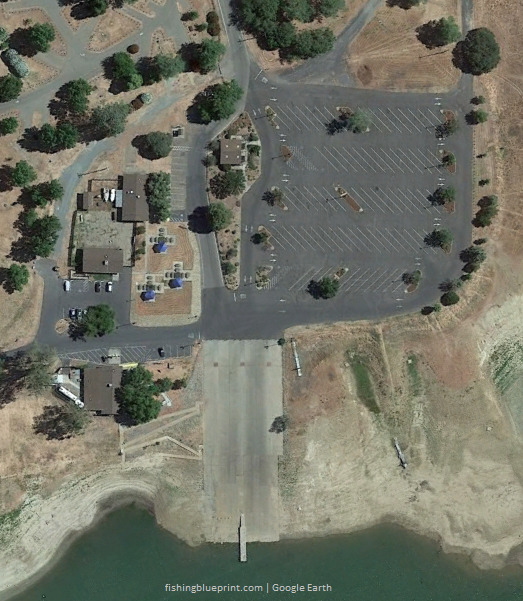
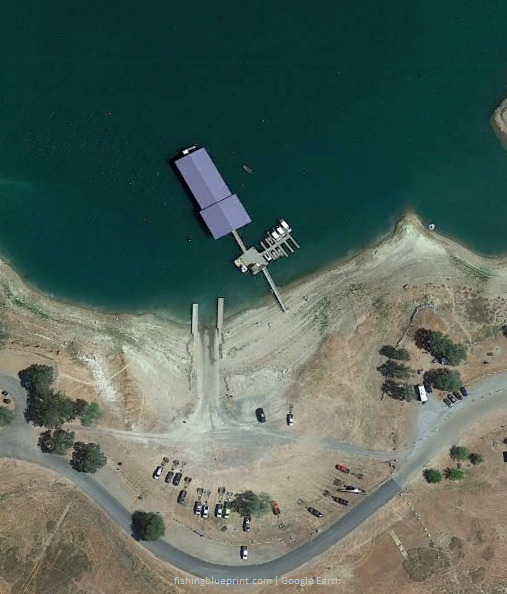
Address: Pattison Rd, Wallace, CA 95254
Website: golakecamanche.com
Phone number: (209) 763-5121
Lanes: Yes, 6
Restrooms: Yes
Showers: no
Gas: Yes
Tackle, groceries, snacks available: Yes
Fish Cleaning Station: Yes
Camping nearby: Yes
Marinas at Lake Camanche
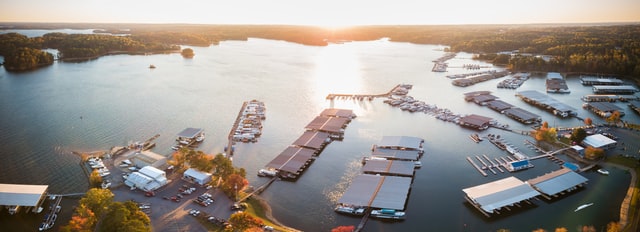
Luckily there are multiple marinas for you to choose from. Here are the ones we found for you.
North Shore Camanche Marina
Address: Shawnee Ct, Ione, CA 95640
Website: golakecamanche.com
Phone number: (209) 763-5166
Nearby boat ramp: Yes, 6 lanes
Restrooms: Yes
Showers: no
Gas: Yes
Tackle, groceries, snacks available: Yes
Fish Cleaning Station: Yes
Camping nearby: Yes
South Shore Camanche Marina
Address: Pattison Rd, Wallace, CA 95254
Website: golakecamanche.com
Phone number: (209) 763-5121
Nearby boat ramp: Yes, 6 lanes
Restrooms: Yes
Showers: no
Gas: Yes
Tackle, groceries, snacks available: Yes
Fish Cleaning Station: Yes
Camping nearby: Yes
Tackle Shops Near Lake Camanche
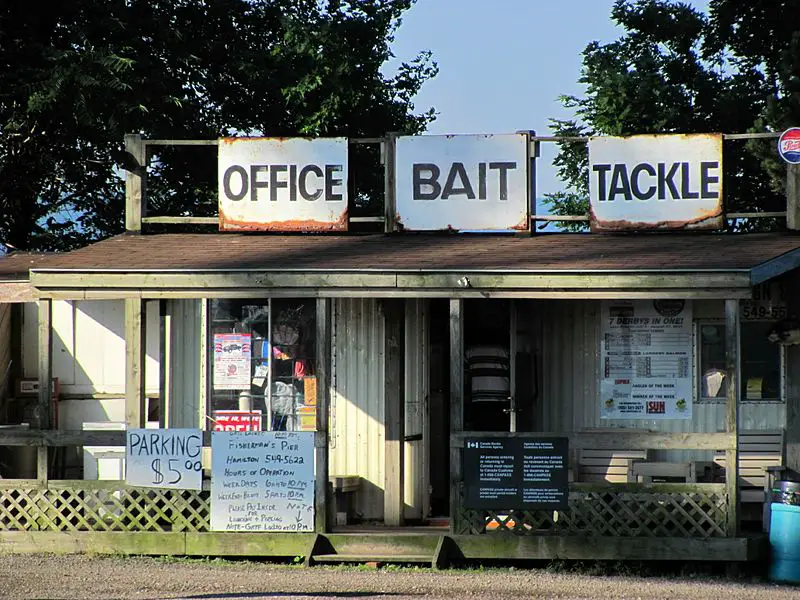
HOOKD
- Address: 106 E Main St, Ione, CA 95640
- Phone: (209) 790-5100
Glory Hole Sports
- Address: 2892 CA-49, Angels Camp, CA 95222
- Phone: (209) 736-4333
The Trout Spot
- Address: 2037 CA-4 Suite A, Arnold, CA 95223
- Phone: (800) 822-7129
Ebbetts Pass Sporting Goods
- Address: 925 CA-4 # A, Arnold, CA 95223
- Phone: (209) 795-1686
Gateway Adventure Co
- Address: 100 Town Square Rd Suite A, Copperopolis, CA 95228
- Phone: (209) 703-5673
Sierra Mountain Outdoors
- Address: 33 Main St, Sutter Creek, CA 95685
- Phone: (209) 267-5909
In Summary...
As you now can see Lake Camanche fishing can be tough at times, but it’s not impossible and with the help of the Lake Camanche Fishing Report… It definitely helps you get started on the right foot quickly and easily, so you can avoid wasting hours wondering where and how to get started.
Did You Get All This?
As fellow fisherman and content creator I thrive on helping others… I feel like I can do the most good by helping others… And frankly… I would feel like I did something wrong if you didn’t walk away feeling a little better about this lake.
I truly want to over deliver for you…
So Let Me Ask You Another Question…
After reading this helpful report:
- Can you see how this could change the way you would fish this lake?… To make it easier, faster… and… with less headache, less frustration?
- If nothing else, do you now have a better sense of where you can get started, even if you have have been here?
- Do you feel that you have a good grasp of what species to expect in this lake?
- Do you have a good understanding what baits are needed to catch each of the different species of fish?
- Earlier we came up with some helpful spots to catch more fish, can you see yourself considering any one of those spots? Which ones are you the most excited about implementing when you get to the lake?
- Is it fair to say that using these spots would give you a significant advantage over someone else who’s fishing this lake?
I Need To Ask A Favor From You And It’s Not Going To Cost You A Single Dime…
If you have gotten anything out of this free report; whether its knowing where to get started, what kinds of fish are in Lake Camanche, what baits to use, where to launch your boat, where to buy a frosty beverage, where to camp, and other things to do when you’re at this lake…
Then I need you to do something that is going to help you your fellow angler…
And that is share this report. Please share it to as many people as you can. It’s free to you and it really helps me out as a creator.
Lastly… thank you for spending your time reading through this report and I hope you have a luck on the water.
THIS IS WHERE YOU CAN HELP ME THE MOST: There’s a lot of information about this subject you have found helpful, and I’m sure you’ll be able to put some of the knowledge bombs to use. But sharing this report helps drive traffic which in turn helps me at absolutely no cost to you. I love creating reports like this for you, and you like reading these types of reports please share this with your friends, family, and fellow anglers.
Click on your favorite social media buttons to share this page now!
Other California Related Fishing Articles
- Bass Lake Fishing Report
- Clear Lake Fishing Report
- Castaic Lake Fishing Report
- California Delta Fishing Report
- Diamond Valley Lake Fishing Report
- Don Pedro Reservoir Fishing Report
- Eagle Lake Fishing Report
- El Capitan Reservoir Fishing Report
- Lake Berryessa Fishing Report
- Big Bear Lake Fishing Report
- Folsom Lake Fishing Report
- Irvine Lake Fishing Report
- Lake Almanor Fishing Report
- Lake Camanche Fishing Report
- Lake Isabella Fishing Report
- Lake Havasu Fishing Report
- Lake McClure Fishing Report
- Lake Oroville Fishing Report
- Lake Perris Fishing Report
- Lake Piru Fishing Report
- Lake Skinner Fishing Report
- Lake Tahoe Fishing Report
- Los Banos Reservoir Fishing Report
- New Hogan Lake Fishing Report
- New Melones Lake Fishing Report
- O’Neill Forebay Fishing Report
- Pardee Lake Fishing Report
- Pyramid Lake Fishing Report
- San Luis Reservoir Fishing Report
- San Vicente Reservoir Fishing Report
- Shasta Lake Fishing Report
- Silverwood Lake Fishing Report
- Trinity Lake Fishing Report
- Whiskeytown Lake Fishing Report
More articles just for you...
Funny Fishing Rules, Laws, and Regulations 2025
Crazy Fishing Laws That Will Blow Your Mind! #7 is INSANE! Strange Fishing Regulations and Laws As silly as hook and rod limits may seem,
EXPOSED! How To Use A Spinnerbait The Right Way for 2025
Are You Wondering How To Use A Spinnerbait? Or How To Work A Spinnerbait Over Grass, Logs, or Points? Well, All These Questions Are Answered
EXPOSED! Best Crankbait Colors for 2025 [Which to Buy & Avoid]
What color crankbait to use? Crankbait Color Chart I just love going into a Bass Pro Shops store and just staring at all the walls
Best Underwater Dock Lights For Fishing – 2025 Buyers Guide
Night Dock Light Fishing For Beginners Dear fellow angler, Does this sound like you? You’re someone who loves fishing but just wants to escape the
15 Best Deep Diving Crankbaits [2025 Buyers Guide – Which to Buy & Avoid]
A Complete Buyer’s Blueprint On The Best Deep Diving Crankbaits for Bass, Walleye, or Striped Bass On The Market Today Fishing deep diving crankbaits can
